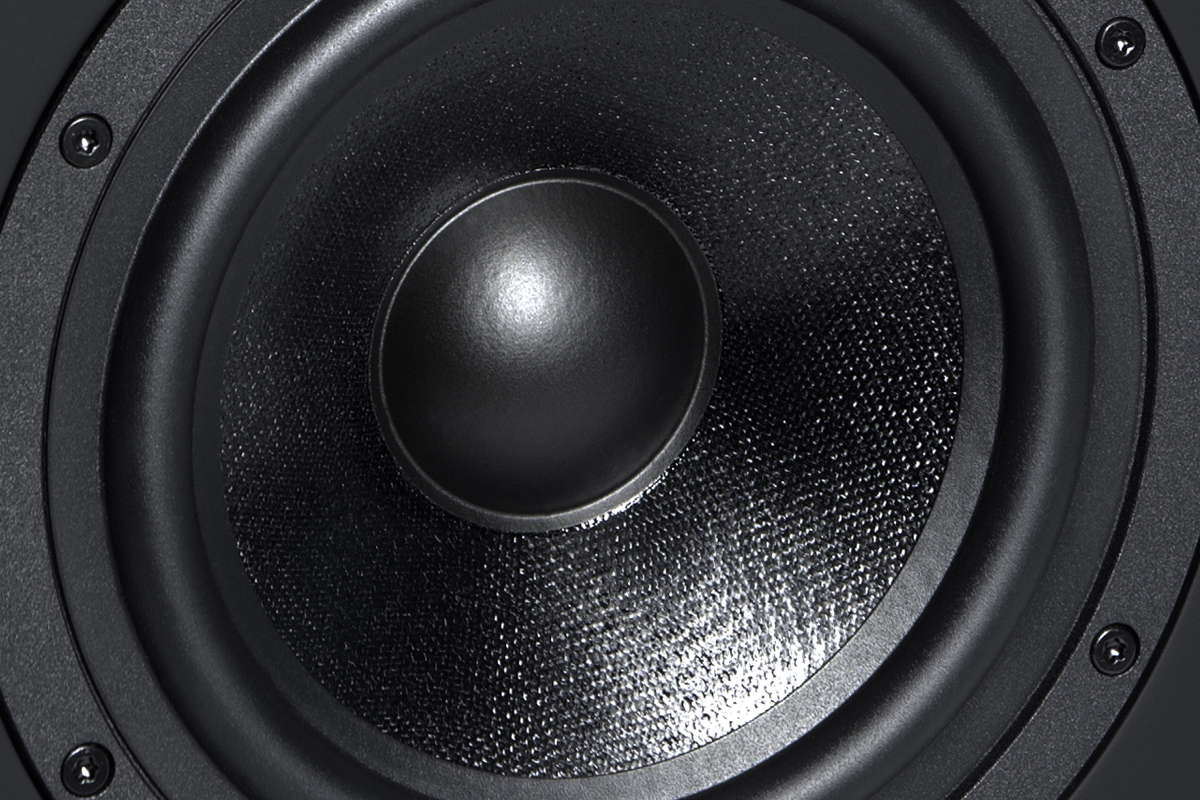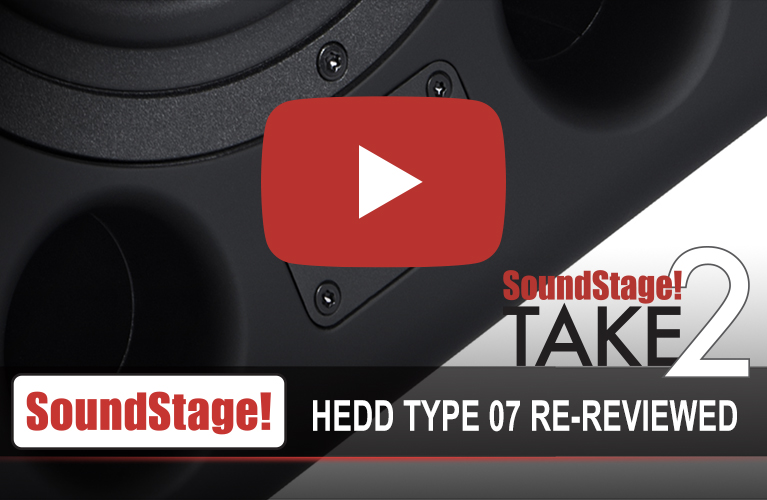When computer audio took off, a decade ago, many hobbyists opted to use active studio monitors, rather than the usual amplifier and passive speakers. It’s not hard to see why. Especially for desktop audio, where space is at a premium, speakers with built-in amps are convenient.
Moreover, the listening experience of desktop audio in some ways reflects how most recordings are made. As Wes Marshall outlined in a 2014 feature on SoundStage! Xperience, sound engineers typically monitor recordings through small speakers placed only 3’ to 5’ away from their ears. Why not use the same speakers recording engineers use for desktop listening?
But active studio monitors can also work well for traditional sit-down listening in a family room or dedicated music room. Not surprisingly, pro-audio brands are beginning to cultivate hi-fi listeners as a secondary market.
One such brand is Heinz Electrodynamic Designs (HEDD), based in Berlin, Germany. According to Lily Luo, CEO of HEDD’s Canadian distributor, Motet Distribution of Markham, Ontario, “HEDD is trying to break into more hi-fi stores in North America. They have had some success already in the music/pro channel.”
HEDD, a fairly young company, was formed in October 2015 by physicist Klaus Heinz, who serves as CTO, and his son Frederik Knop, a musicologist and recording engineer, who serves as CEO. Earlier in his career, Heinz founded another studio monitor manufacturer, Adam Audio, also based in Berlin.
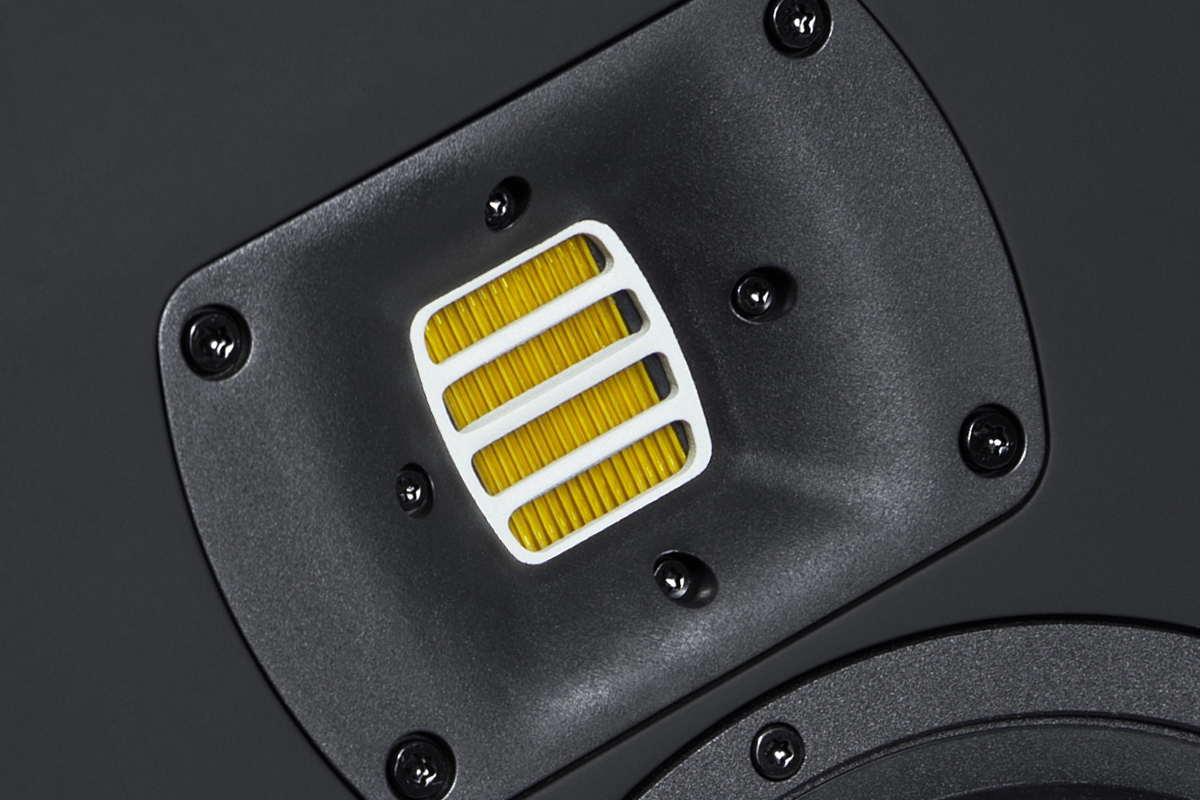
One of HEDD’s signature technologies is their Air Motion Transformer (AMT) tweeters, which they use in all of their speakers. The company’s HEDDphone, which has been getting a lot of attention, employs a full-range AMT.
Unlike cones and domes, which push air pistonically to create soundwaves, AMT tweeters move air by squeezing and expanding a pleated diaphragm in accordion fashion. Audio signals are sent to conductive tracings embedded in this diaphragm, which is suspended in a magnetic field. Advantages of AMTs over conventional dynamic tweeters include higher output and faster transient response, HEDD says. They also claim that Heinz’s AMTs improve on earlier designs through the use of powerful neodymium magnets that permit higher output at lower distortion, and a plastic waveguide that makes possible a lower crossover frequency.
Inside and out
HEDD’s Type 07 Nearfield Studio Monitor (as they call it) costs $1700/pair (all prices USD), and has a 7.2” honeycomb composite woofer with a 1.5” voice-coil, crossed over at 2.3kHz to the AMT tweeter. Each driver has its own 100W ICEpower class-D amplifier. The Type 07’s specified frequency range is 38Hz-50kHz, with a maximum SPL of more than 116dB at 1m and with 3% THD.
Measuring 14.6”H x 8.7”W x 11.8”D and weighing 21.2 pounds, the Type 07 has a grippy matte-black finish that gives it a substantial feel and a utilitarian look befitting its primary application as a studio monitor. The top and bottom edges of the front baffle are rounded, and slope gracefully inward to the top and bottom panels. The Type 07 has two bass ports, one each in the bottom left and right corners of the front baffle.
Between the ports are three LEDs. The red LED, on the left, illuminates when the protection circuitry kicks in; the green LED, at center, glows to indicate power-on; and the white LED lights up when the speaker is synchronized with an optional HEDD Bridge networking card (which is used only in studio applications).
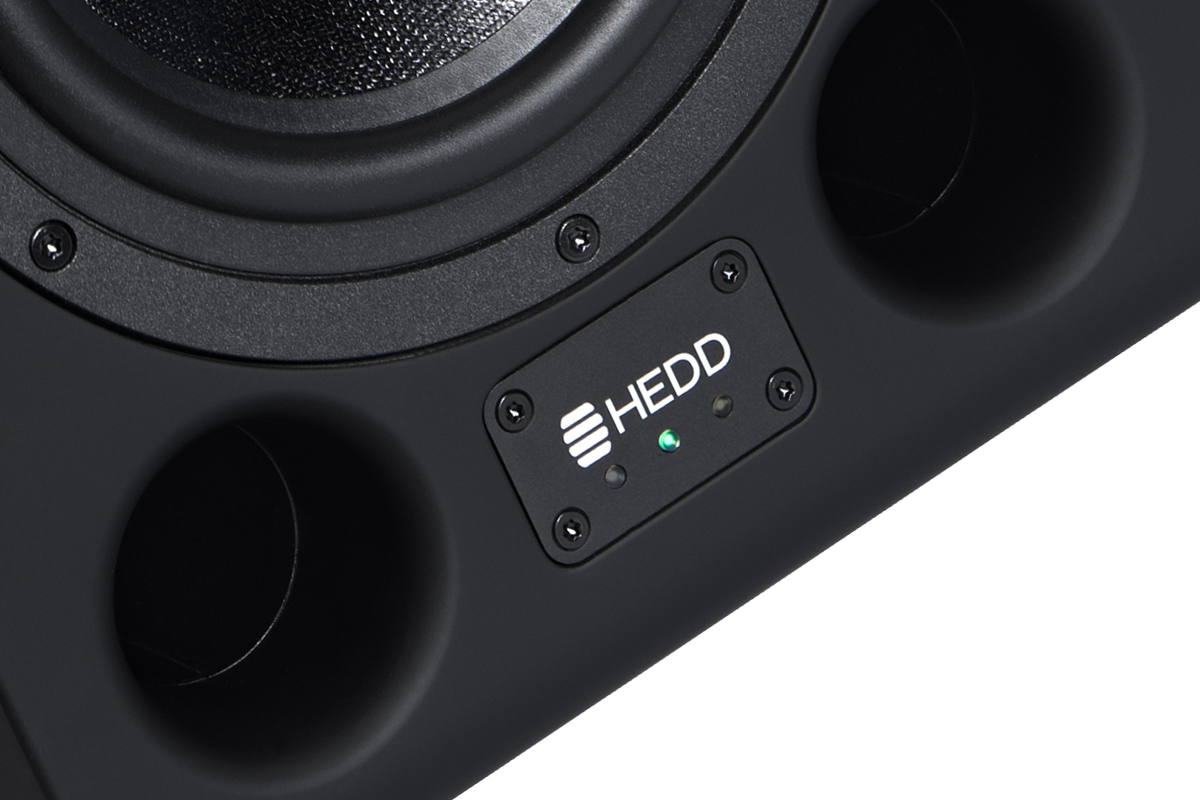
No grilles are provided, but the AMT’s pleated diaphragm is protected by the slotted white front magnet/pole plate. The screws securing the drivers to the baffle are visible, but as they’re painted black, they’re visually unobtrusive.
On the bottom right of the rear panel is an IEC power inlet, and beside it an on/off rocker switch. Above that are the two line-level inputs, balanced (XLR) and unbalanced (RCA); above those is a Source switch with three positions: HEDD Bridge, Unbalanced, and Balanced.
Above the Source switch are: a Gain dial with a range of -30 to +6dB; a High Shelf dial that provides adjustment of ±2dB at 2kHz and ±4dB at 20kHz; and a Low Shelf dial that provides adjustment of ±2dB at 200Hz and ±4dB at 50Hz. The shelf controls are potentially quite useful for compensating for room-boundary reinforcement and room acoustics.
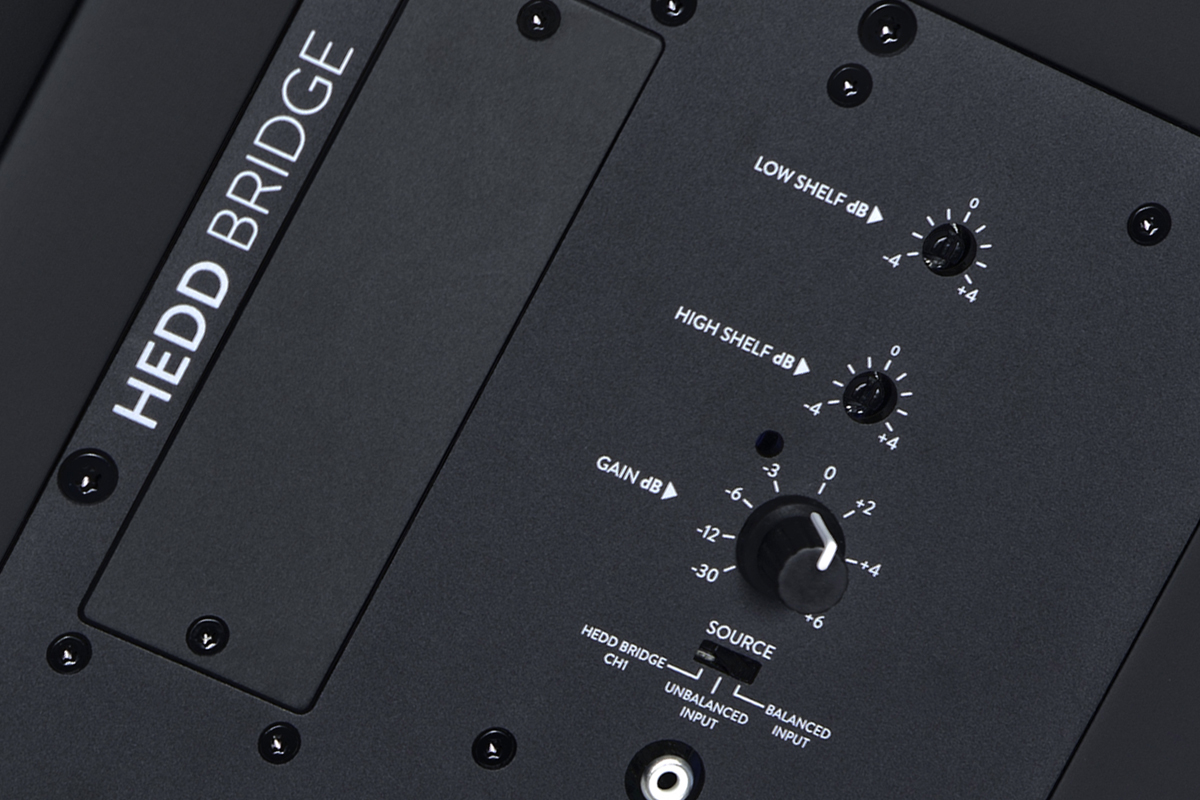
On the left side of the rear panel is a tall, narrow bay for inserting the optional HEDD Bridge digital input card. This card allows HEDD speakers to be integrated into pro-audio production systems that employ Audinate's Dante audio-over-IP protocol, and is not relevant for home applications.
Setup and software
Each Type 07 ships with a Quick Start guide that covers the basics; available on HEDD’s website is a commendably clear and complete Operation Manual.
The front page of the Quick Start guide prompts the user to download the free HEDD Lineariser app for Windows or Mac. For some listeners, this will be a worthwhile enhancement. Lineariser has settings for all HEDD speakers; when active, it optimizes the phase and amplitude response of the selected model.
For amplitude response, users can choose either the HEDD alignment curve, which provides a modest LF boost, or Anechoic flat response. The HEDD curve “represents what we consider to be the ideal sound for conventional listening rooms,” HEDD states in Lineariser’s documentation. “It exhibits a bass response identical to the analog HEDD design.” In other words, the HEDD alignment curve reflects the HEDD speaker’s innate voicing.
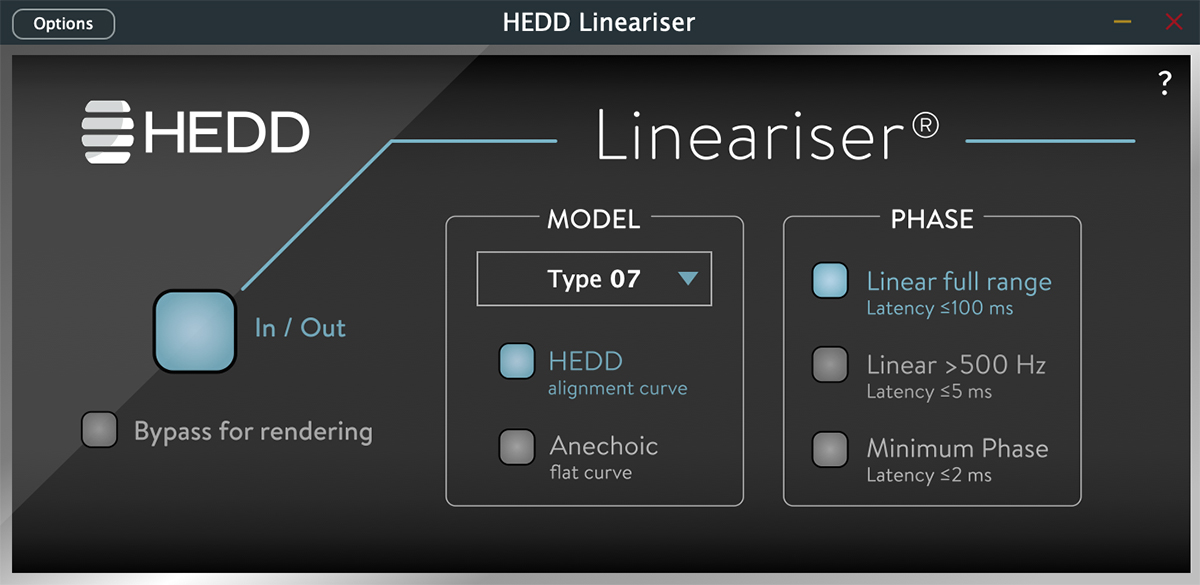
There are three settings for phase correction. Linear Full-Range, which HEDD recommends, delivers flat phase response through the entire audioband, but with a latency of about 100msec. This will be a problem in some professional applications, but rarely for home listening (the only exception might be watching videos). Linear >500Hz has lower latency, about 5msec, but performs phase correction only from 500Hz up. Minimum Phase reduces latency to 2msec, but performs only amplitude-response correction.
Lineariser can be used in professional applications as a plug-in for a digital audio workstation (DAW) application such as Pro Tools. It can also be used as a plug-in in the foobar2000 music-player app for Windows.
Windows and Mac users can also configure Lineariser as a standalone application, to process output from whatever music-player app they’re using before routing it to a soundcard or connected DAC. In this mode, Lineariser requires a utility that grabs output from the music app, and then performs Lineariser processing. In the Lineariser documentation, HEDD recommends the apps VB-Cable for Windows and Soundflower for macOS.
I don’t have a Windows PC, and Soundflower refused to install on my early-2015 Apple MacBook Pro. In an e-mail exchange, Knop suggested I try Rogue Amoeba Software’s SoundSource -- a full license costs $29, but there’s a free trial version that will work for 20 minutes per session.
There’s no guidance on using Lineariser with SoundSource in HEDD’s documentation, so I had to figure it out for myself. When you launch SoundSource, an icon appears in the menu bar of macOS. Clicking the SoundSource icon opens a window showing the default audio applications on your Mac. You can add other music apps to the list. Beside each item is a drop-down menu that lets you redirect audio from the app to the device of your choice.
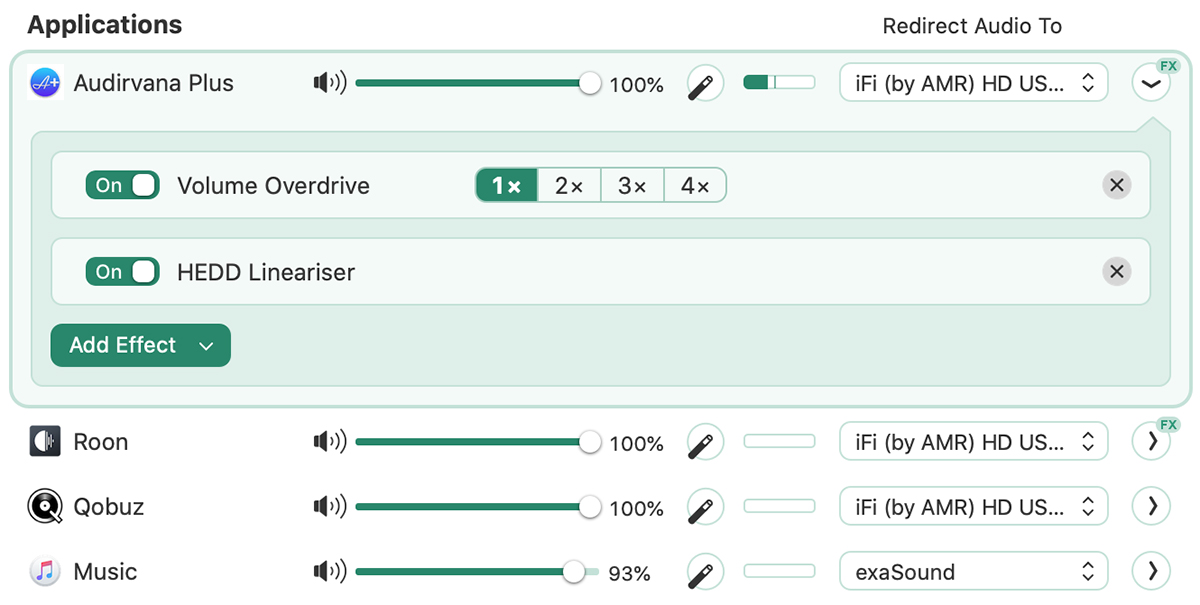
Clicking the arrow beside the redirect menu lets you add effects such as ten-band graphic equalization, and Audio Units plug-ins such as HEDD Lineariser. Click on the HEDD Lineariser option in SoundSource to open the Lineariser window, where you can confirm the HEDD model you’re using and choose the effects you want -- or bypass them altogether.
Assessing Lineariser’s sonic benefits was difficult, because the software reduces the speaker’s output by 9dB in order to leave enough headroom for processing. Whenever I switched Lineariser in, I had to boost the level by 9dB, then cut it by 9dB when I switched it out. That made instantaneous comparisons impossible.
Still, listening to a variety of instrumental jazz, classical, and vocal tracks through two different DACs (an exaSound e32 Mk.II and an iFi Audio Pro iDSD), with Linear Full-Range phase correction and the HEDD alignment curve selected, I thought the sound was a tad more spacious and a tad less glary compared to the unprocessed output. But the difference was very small.
I also compared the HEDD and Anechoic alignment curves. With the Anechoic curve the sound was leaner, more incisive; with the HEDD curve, it was warmer and richer. I preferred HEDD, but I can see others opting for the more analytical sound of Anechoic.
I heard enough to know that if I were using HEDD speakers for nearfield desktop listening from a PC or Mac, I’d want to use Lineariser -- with one possible complication: Lineariser doesn’t support DSD. If you try to play a DSD file through Lineariser, all you’ll hear will be hashy noise -- even if your music-player app and DAC both support DSD and the software indicates that playback is proceeding properly. If, like me, you have a lot of DSD albums in your library, it’s best to pass on Lineariser.
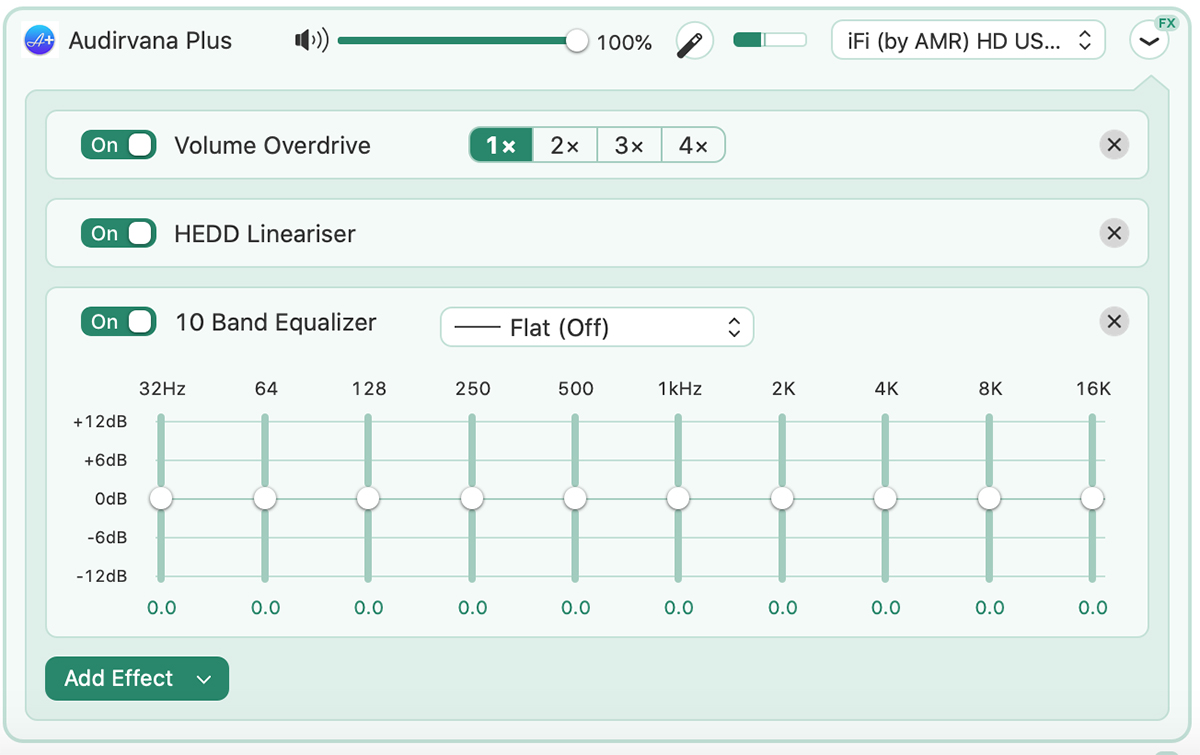
In any event, I don’t often listen to music at my desk. I prefer to listen Simplifi-style: sitting on a couch or comfy chair, cueing up music on my iPad Mini, and sending it to a network streamer. So for most of my listening, I connected the Type 07s’ balanced inputs to the balanced outputs of an exaSound e32 Mk.II DAC ($2495) using a 2m pair of Argentum Acoustics Mythos XLR interconnects. The music source was an exaSound Sigma streamer ($750), connected to the e32 Mk.II with a 2m AudioQuest Pearl USB link. I streamed music to the Sigma via Wi-Fi from the Apple Mac Mini in my second-floor home office, which runs Roon Core. I did all of my listening with the Type 07s’ EQ Shelf dials set to flat, and their Gain controls to 0dB.
Listening I
I began with some slightly-farther-than-nearfield listening, with the Type 07s set up to either side of a credenza on the long wall of my basement family room, atop isoAcoustics ISO-200 desktop speaker stands. In those locations, the speakers were 4’ apart; their front baffles were 5’ from my listening chair against the opposite wall, and their rear panels were 1’ from the wall behind them. Per the manual’s recommendation, I toed the Type 07s in slightly. With this setup, I found the Type 07s’ sound hugely involving -- they immersed me in whatever music I listened to.
HEDD’s AMT tweeter proved its mettle with Fantaisie, a new album of solo-piano music by Schubert performed by French pianist David Fray (24-bit/96kHz FLAC, Erato/Qobuz). In the first movement of the Piano Sonata in G Major, D.894, “Fantasie,” Fray draws all kinds of color from his Steinway, and particularly notable was the crystalline quality in his upper-octave runs -- through the Type 07s, they were meltingly beautiful.
In tender passages, Fray elicits from his instrument a muted 19th-century character, and the Type 07s communicated this wonderfully. I admired how they rendered his subtle legato touch and expressive pedaling, and how his notes decayed into the resonant acoustic of L’église Notre-Dame-du-Liban, in Paris, where Erato has made more than 1200 recordings.
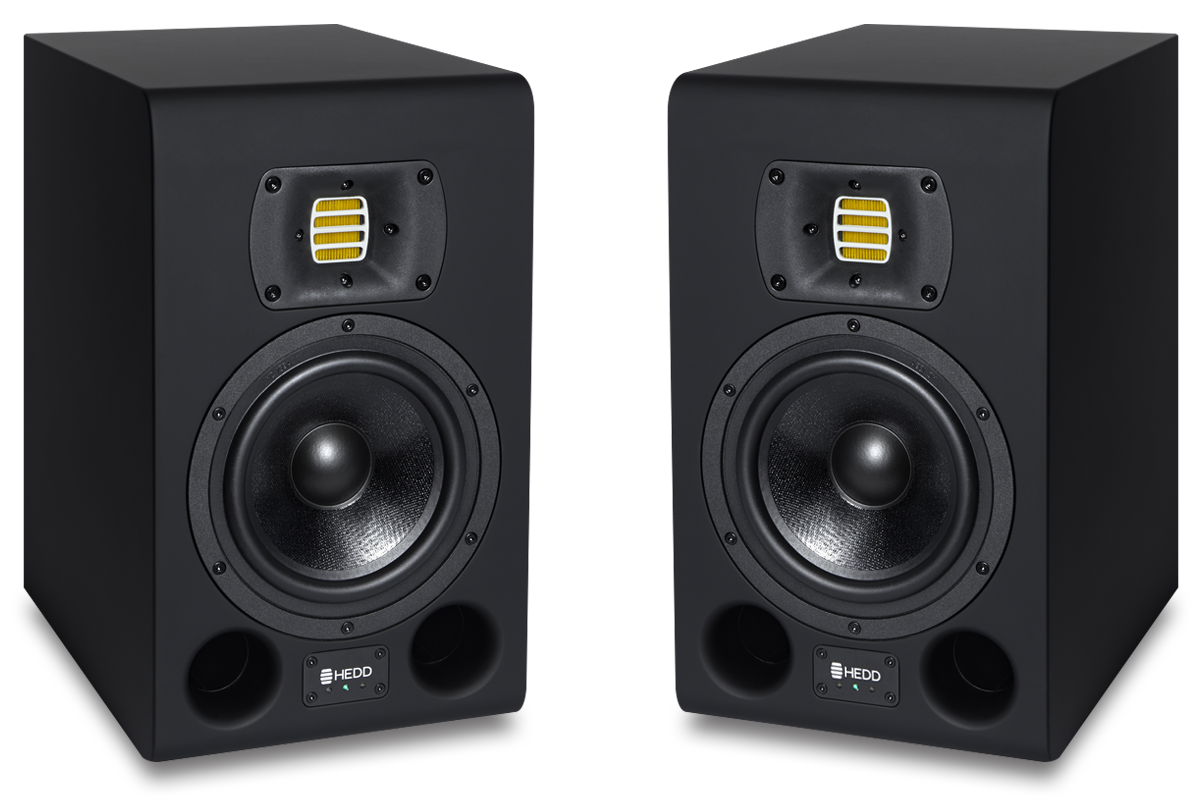
Through the piano’s entire range, Fray’s staccato notes and chords had impressively fast attacks without glare, and natural sustain and decay. In dramatic passages, dynamics scaled naturally and effortlessly. While it would be unrealistic to expect a pair of two-way active minimonitors to convey the full power of a Steinway concert grand, the Type 07s delivered a very satisfying facsimile, with plenty of authority in the lower octaves and no hint of compression. However, just a little hardness crept into fortissimo passages played back at high volumes, especially in the upper octaves.
The Type 07s could definitely party, as I confirmed by streaming the long version of “Jamming” from Bob Marley & the Wailers’ Exodus (24/96 FLAC, Island/Qobuz). Aston “Family Man” Barrett’s Fender Jazz bass, just to right of center, pounded, giving this reggae masterpiece fantastic momentum. The bass was loud, deep, and robust, with no compression or muddiness.
Spread all over the soundstage (there’s quite a bit of stereo widening going on here), Alvin “Seeco” Patterson’s percussion and Carlton “Carly” Barrett’s drums had impressive snap and impact. True, cymbals sounded a little hot and splashy, but that’s a quality of the recording that the Type 07s revealed without accentuating.
The two electric guitarists -- one at left slamming a hard reggae beat on the upper strings, the other at center playing wah-wah accents that sound almost human -- had an edge that really suit this music; again, a property of the recording. And the voices of Marley and his female backing singers were admirably free of coloration. Had we wanted to push all the furniture to the walls and party to this track, the Type 07s would easily have obliged.
Comparison I
Elac’s Navis ARB-51 analog active loudspeaker ($2299.98/pair) received Reviewers’ Choice honors when I reviewed it in April 2019, and a SoundStage! Network Product of the Year Award for Exceptional Value. The three-way ARB-51 has a coaxial driver comprising a 4” aluminum midrange powered by a 100W BASH amplifier and a 1” soft-dome tweeter driven by a 40W class-AB amp. Bass is produced by a 5.25” aluminum-coned woofer backed by a 160W BASH amp. I connected the ARB-51s to the exaSound DAC with the same balanced interconnects I’d used for the Type 07s. Elac’s Navis speakers have three EQ switches, one each for LF, MF, and HF -- I left each in its flat setting.
Through the Navis ARB-51s, David Fray’s recording of Schubert’s Piano Sonata D.894 had greater harmonic richness and depth in the middle and lower registers than through the HEDDs, a little less sparkle and articulation in the upper register. With the Type 07s, I had a slightly better sense of Fray’s touch -- his sound was richer through the Elacs, more expressive through the HEDDs. Through the HEDDs, I also had a better sense of the rich acoustic of that eastern-rite Parisian church. Fortissimo passages played at loud volume settings sounded harder through the HEDDs than through the Elacs, but dynamics through the latter weren’t quite as exciting -- the Elacs seemed a tad compressed.
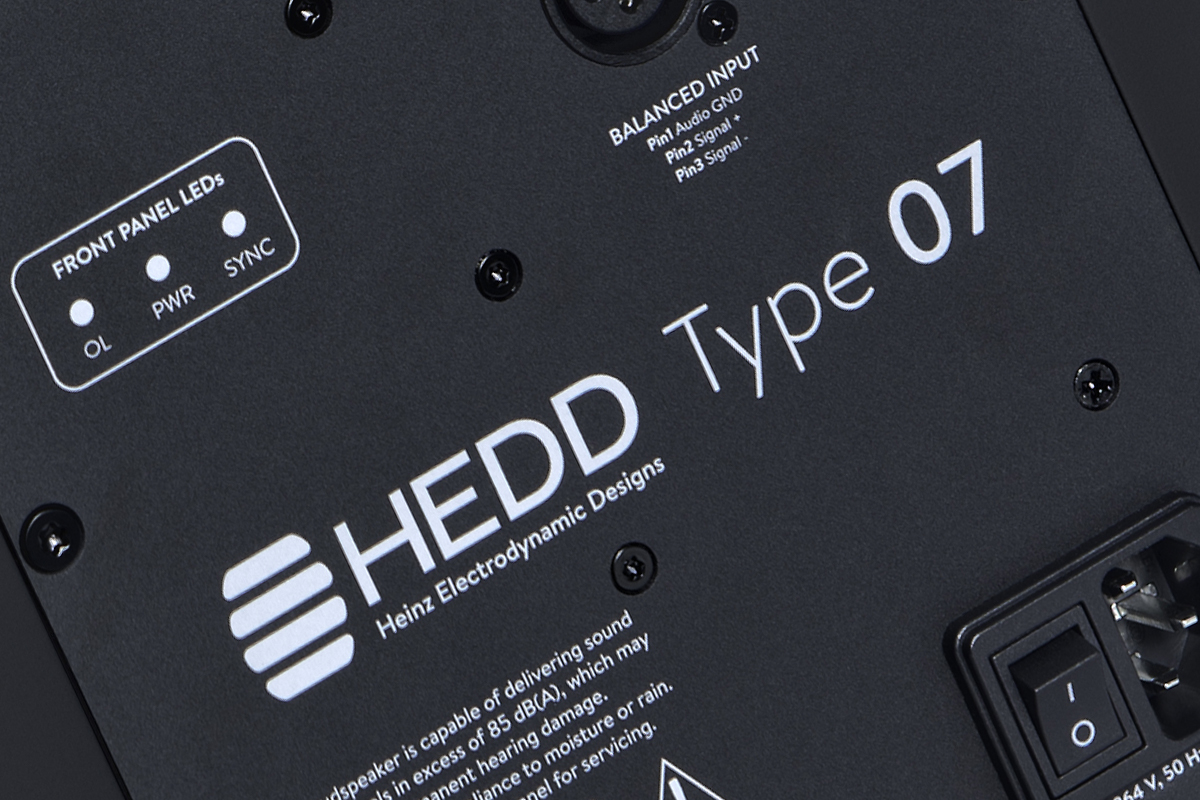
Next up on my review schedule is another pair of active studio monitors: Focal’s Shape 65 ($1998/pair), which employs a 6.5” Flax sandwich-cone woofer powered by an 80W class-AB amp and a 1” aluminum-magnesium inverted-dome tweeter driven by a 25W class-AB amp. The bass loading comprises a pair of 6.5” passive radiators, one on each side panel. Like the Elacs and HEDDs, the Focals have both unbalanced (RCA) and balanced (XLR) inputs; I used the latter to connect them to the exaSound e32 Mk.II DAC, and left all of the Shape 65s’ EQ settings in their flat position.
With the David Fray piano recording, the Focals had wonderful richness in the middle register. While the upper octaves didn’t have quite the sparkle they had through the HEDDs, they were nonetheless beautifully articulate. Middle-octave chords had fabulous authority -- more than the HEDDs. The decay of Fray’s piano into the sanctuary’s resonant acoustic was hugely involving, again the equal of the HEDDs. Dynamics were tremendously exciting -- definitely comparable to the HEDDs. During fortissimo passages played back at high volumes, high notes sounded less hard through the Focals than through the HEDDs, but the Focals were a tad harder in the upper-middle register.
Listening II
I conducted my Listening II session in our main-floor living room, placing the Type 07s on 28"-high Monoprice Monolith speaker stands to either side of our faux fireplace. The HEDDs were 7’ apart and 7’ from my listening spot -- the end cushion of a sectional sofa against the opposite wall -- with their tweeters precisely at my ear height when seated. Their rear panels were 16” from the front wall.
Measuring 12’L x 9’W x 9’H, our living room isn’t all that big, but opens onto a hallway and dining room. So the little HEDDs had a much greater volume of air to pressurize than they did in our low-ceilinged basement family room, and a lot more scope to strut their stuff -- which they did.
Despite their utilitarian styling, the HEDDs didn’t look out of place. Their matte black matched the black-crackle finish of the Monolith stands, so they weren’t visually obtrusive, at least to me -- my more design-conscious wife thought they looked a bit bulbous.
Sonically, though, the Type 07s disappeared, throwing a wide, deep, high soundstage that extended far past the speakers in every dimension. At no point did the sound seem to emanate from the two black boxes flanking our fireplace.
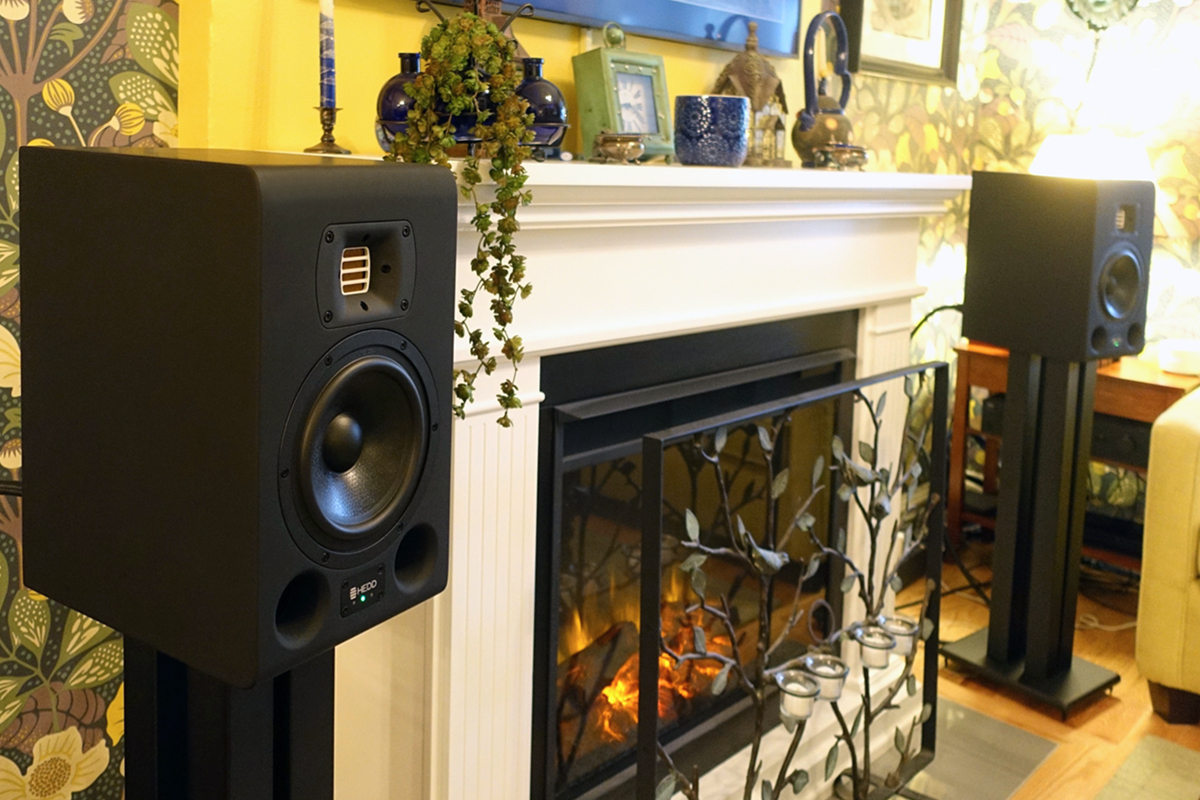
The third track on The Women Who Raised Me, by American jazz singer Kandace Springs (24/96 FLAC, Blue Note/Qobuz), is one of the most unusual and effective musical juxtapositions I’ve ever heard. It opens with Springs playing, on unaccompanied piano, the main theme of the first movement of Beethoven’s Piano Sonata No.14, “Moonlight.” The piano’s tone was every bit as gorgeous as it had been with David Fray playing Schubert: rich and resonant, with a wonderful bell-like quality.
This brooding introduction then segues into an intense performance of Screamin’ Jay Hawkins’s “I Put a Spell on You,” throughout which Springs continues to play that theme from “Moonlight.” I was bowled over by the way the Type 07s reproduced Springs’s expressive alto, which hovered about a foot above the speaker plane. Her sibilants never sounded hot or spitty, but every word, and every nuance of her enunciation of it, were perfectly intelligible. And when she ramped up the drama, the HEDDs scaled effortlessly. David Sanborn’s alto saxophone jumped out into the room from the left side of the stereo image, and Clarence Penn’s drums had fantastic impact.
A performance of Astor Piazzolla’s Tango Suite for Two Guitars, from the Katona Twins’ Le Grand Tango (24/96 FLAC, Channel Classics), showed off the Type 07’s speed and agility. The HEDDs impeccably resolved these Hungarian guitarists’ virtuosic runs. Not only could I hear every note on every string, I could easily discern how a chord or run was played -- with a thumb or fingernails, for example -- and the warm tone of the nylon strings. Even with this resolution and detail, the Type 07s never sounded edgy or etched. They presented two realistically sized guitars, one each at left and right, their aural images entirely divorced from the speakers themselves. Equally impressive were the Katonas’ percussive effects on the bodies of their guitars -- they were fast and impactful, without a hint of overhang. Following each slap or knock, I could appreciate both the initial impact and the woody resonance of the guitar’s body.
Comparison II
Available in a high-gloss finish of white, black, or ebony, Elac’s Navis ARB-51 speaker is much more attractive than HEDD’s Type 07, and thus better suited for use in more elegant décors.
The Elacs delivered a warmer but slightly less incisive reproduction of Kandace Springs’s cover of “I Put a Spell on You.” As with Fray’s Schubert, the tone of Spring’s piano was fuller and richer through the Elacs, but didn’t have quite the crystalline clarity provided by the HEDDs. Springs’s voice was warmer and more rounded through the Elacs, which gave it a more convincing flesh-and-blood quality, but sounded a little more expressive through the HEDDs. The Elacs’ soundstage wasn’t as deep and high as the HEDDs’, but their specificity of aural image was better: Springs’s alto voice and Sanborn’s alto sax locked more firmly in place on the soundstage. Through the Elacs, the mix sounded a tad more congested than through the HEDDs.
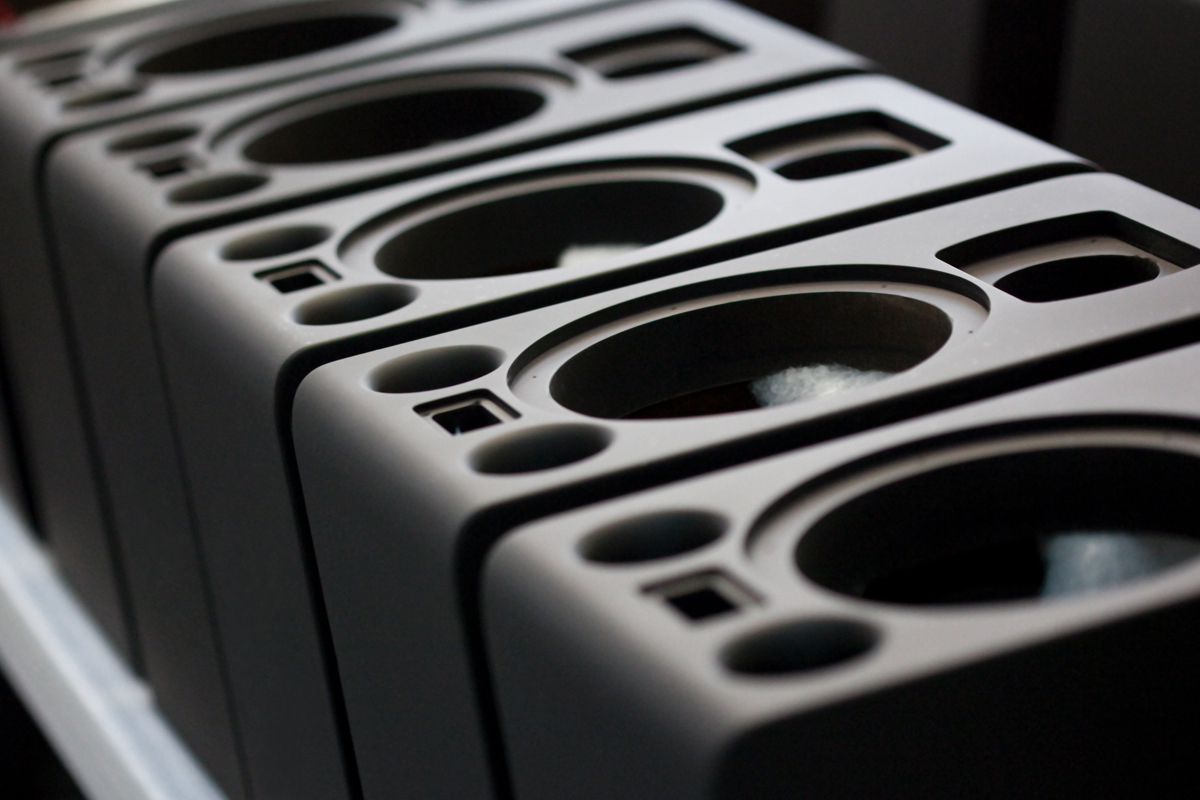
The front baffle of Focal’s Shape 65 minimonitor curves gracefully upward to the top panel, which on my review samples was finished in genuine dark walnut. This, combined with the grilles protecting the woofer and tweeter, gives them a pleasingly retro look that my infinitely better half very much liked.
Compared to the HEDDs, the Focals generated a bit more dynamic excitement with “I Put a Spell on You.” Springs’s voice was more forward, right at the plane described by the speaker baffles -- I found her vocals a bit more lifelike than through the HEDDs. Penn’s drums also hit a little harder through the Focals, and piano attacks were a little sharper and faster, the instrument sounding a bit bigger -- but piano-note decays were longer with the HEDDs, which gave me a more convincing sense of a real instrument being played in a real space. The Focals’ presentation of space was flatter, the mix thus sounding a little denser -- with the HEDDs, I could get further “inside” this track.
Conclusion
Can a speaker designed for use as a professional nearfield studio monitor work well for sit-down living-room listening? Based on my experience with the HEDD Type 07, I’d say the answer is a resounding yes. Throughout my listening, I admired the crystalline clarity of the Type 07’s AMT tweeter, which made it sound fast, agile, and articulate. These speakers could also rock -- the Type 07s had no trouble filling my main-floor living area with big, dynamic sound that was always a delight to listen to.
Any hesitation I might have about using the Type 07s for home listening has to do with their appearance. They’re by no means unattractive, but unlike Elac’s Navis ARB-51 active speakers, their cabinets are definitely not furniture-grade. Cosmetically, they’d be at home in a casual space like my basement family room -- but in an elegant living room, not so much. Of course, that cuts both ways. High-gloss, furniture-grade enclosures are costly to build. At $1700/pair, the Type 07 costs $599.98/pair less than Elac’s ARB-51.
But in terms of sound, the HEDD Type 07 is a fantastic value.
. . . Gordon Brockhouse
Associated Equipment
- Active loudspeakers -- Elac Navis ARB-51, Focal Shape 65
- DAC -- exaSound e32 Mk.II, iFi Audio Pro iDSD
- Streamer -- exaSound Sigma
- USB link -- AudioQuest Pearl (2m)
- Computers -- Apple MacBook Pro (early 2015) and Mac Mini (mid-2011)
- Control device -- Apple iPad Mini 3
- Interconnects -- Argentum Acoustics Mythos balanced (XLR, 2m)
- Speaker stands -- isoAcoustics ISO-200, Monoprice Monolith (28”)
HEDD Type 07 Analog Active Loudspeakers
Price: $1700 USD per pair.
Warranty: Two years parts and labor.
HEDD Audio GmbH
Salzufer 13/14
10587 Berlin
Germany
Website: www.hedd.audio/en/





